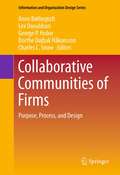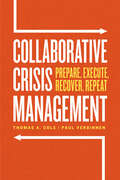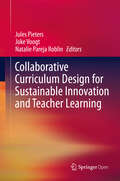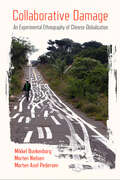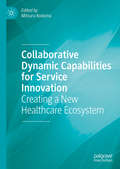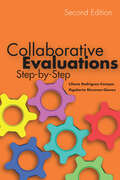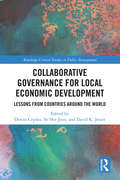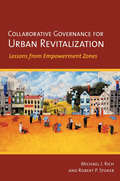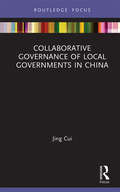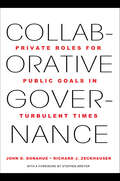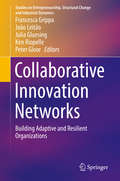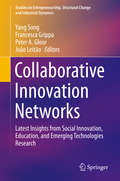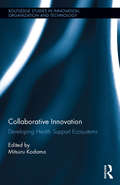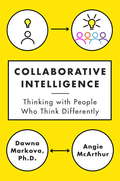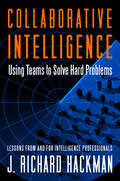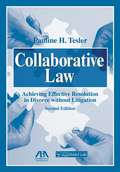- Table View
- List View
Collaborative Communities of Firms: Purpose, Process, and Design (Information and Organization Design Series #9)
by Charles C. Snow Dorthe Døjbak Håkonsson Lex Donaldson Anne Bøllingtoft George P. HuberFaced with the ever-accelerating pace of technological change and the restructuring of markets, many firms have been questioning the appropriateness of their own organizational structure and effectiveness. Consequently, we have witnessed much organizational experimentation and the development of new forms of organizing over the last decade. Firms are more dependent than ever on the need for continuous and radical innovations - and often innovations that go beyond their existing businesses. This challenges firms in terms of knowledge and idea sharing, and often necessitates the need to expand beyond the boundaries of the single firm for multi-party collaboration to meet serious challenges and develop creative solutions. Drawing from the Fourth International Workshop on Organization Design, and featuring contributions from an international array of specialists, this volume focuses on the expansion beyond the boundaries of the single firm and multi-firm networks, to include, for example, community-based organization designs. A community is a connected set of firms; the connections can take on many different dimensions. For organization design theory, community-based organizations have many implications. For one, organization design theory has to identify and describe designs that enhance collaborative behavior among firms without restricting the ability of the individual firm to continue to compete within its own marketplace. Moreover, organization design theory also has to identify and describe information processing strategies and designs that allow the continuous generation, sharing, and application of existing information and knowledge. The development of effective collaborative community designs is critically important to the global economy because, increasingly, our future depends on pursuing shared goals and sustainably developing our global commons. Ideally, the ideas and findings in this book will contribute to increased attention to new organization designs capable of meeting 21st-century opportunities and challenges.
Collaborative Crisis Management: Prepare, Execute, Recover, Repeat
by Thomas A. Cole Paul VerbinnenTwo experienced corporate crisis advisors offer a thorough and approachable guide to successful crisis management from anticipation to resolution. All organizations face crises from time to time, and at a time when news, information (or misinformation), and rumors can spread quickly, a timely and thoughtful response to a crisis, is critical. In this book, two industry insiders offer a primer on how organizational leadership should prepare for and handle crises. The steps, plans, and cautions they offer show how organizations can deal openly and honestly with challenges while continuing to survive and prosper. Thomas A. Cole and Paul Verbinnen show how successful crisis management requires a multi-disciplined approach enacted collaboratively under strong leadership. Drawing on many real-world examples, they speak to not only what to do during a crisis, but also the need for preparedness and post-crisis follow-up. The book is organized around a broad range of discrete issues that need to be addressed in managing any crisis and provides the steps required to successfully address each of those issues. The authors urge crisis managers to focus attention equally on four phases of management: prepare, execute, recover, and then repeat (after reflecting on the results of the last crisis) with the next one. The emphasis is on preparation and planning, setting up the procedures, and organizing the teams that will respond to each crisis. Unlike other crisis books that focus solely on communication, Collaborative Crisis Management goes further and in addition to communication, it discusses both the legal obligations and organizational challenges that accompany a crisis. The result is an indispensable guide for leaders, board members, and business students.
Collaborative Crisis Management: Prepare, Execute, Recover, Repeat
by Thomas A. Cole Paul VerbinnenTwo experienced corporate crisis advisors offer a thorough and approachable guide to successful crisis management from anticipation to resolution. All organizations face crises from time to time, and at a time when news, information (or misinformation), and rumors can spread quickly, a timely and thoughtful response to a crisis, is critical. In this book, two industry insiders offer a primer on how organizational leadership should prepare for and handle crises. The steps, plans, and cautions they offer show how organizations can deal openly and honestly with challenges while continuing to survive and prosper. Thomas A. Cole and Paul Verbinnen show how successful crisis management requires a multi-disciplined approach enacted collaboratively under strong leadership. Drawing on many real-world examples, they speak to not only what to do during a crisis, but also the need for preparedness and post-crisis follow-up. The book is organized around a broad range of discrete issues that need to be addressed in managing any crisis and provides the steps required to successfully address each of those issues. The authors urge crisis managers to focus attention equally on four phases of management: prepare, execute, recover, and then repeat (after reflecting on the results of the last crisis) with the next one. The emphasis is on preparation and planning, setting up the procedures, and organizing the teams that will respond to each crisis. Unlike other crisis books that focus solely on communication, Collaborative Crisis Management goes further and in addition to communication, it discusses both the legal obligations and organizational challenges that accompany a crisis. The result is an indispensable guide for leaders, board members, and business students.
Collaborative Crisis Management: Prepare, Execute, Recover, Repeat
by Thomas A. Cole Paul VerbinnenTwo experienced corporate crisis advisors offer a thorough and approachable guide to successful crisis management from anticipation to resolution. All organizations face crises from time to time, and at a time when news, information (or misinformation), and rumors can spread quickly, a timely and thoughtful response to a crisis, is critical. In this book, two industry insiders offer a primer on how organizational leadership should prepare for and handle crises. The steps, plans, and cautions they offer show how organizations can deal openly and honestly with challenges while continuing to survive and prosper. Thomas A. Cole and Paul Verbinnen show how successful crisis management requires a multi-disciplined approach enacted collaboratively under strong leadership. Drawing on many real-world examples, they speak to not only what to do during a crisis, but also the need for preparedness and post-crisis follow-up. The book is organized around a broad range of discrete issues that need to be addressed in managing any crisis and provides the steps required to successfully address each of those issues. The authors urge crisis managers to focus attention equally on four phases of management: prepare, execute, recover, and then repeat (after reflecting on the results of the last crisis) with the next one. The emphasis is on preparation and planning, setting up the procedures, and organizing the teams that will respond to each crisis. Unlike other crisis books that focus solely on communication, Collaborative Crisis Management goes further and in addition to communication, it discusses both the legal obligations and organizational challenges that accompany a crisis. The result is an indispensable guide for leaders, board members, and business students.
Collaborative Curriculum Design for Sustainable Innovation and Teacher Learning
by Joke Voogt Jules Pieters Natalie Pareja RoblinThis open access book provides insight into what it takes to actively involve teachers in the curriculum design process. It examines different aspects of teacher involvement in collaborative curriculum design, with specific attention to its implications for sustainable curriculum innovation and teacher learning. Divided into six sections, the book starts out by introducing the notion of collaborative curriculum design and discusses its historical and theoretical foundations. It describes various approaches commonly adopted to actively involve teachers in the (co-)design of curriculum materials. Sections two and three provide examples of what key phases in the curriculum design process - such as needs analysis, design and development, and implementation - look like across various collaborative curriculum design projects. Section four reports on the impact of collaborative curriculum design on student learning, teacher practices, teacher professional growth, and institutional change. Building on the research evidence about the outcomes of collaborative curriculum design, section five focuses on sustainability, scaling-up and curriculum leadership issues, which are key to the continuation and further evolution of curriculum innovations. Future perspectives are addressed in section six with emphasis on the infrastructure of a sustainable curriculum innovation.
Collaborative Damage: An Experimental Ethnography of Chinese Globalization
by Morten Axel Pedersen Morten Nielsen Mikkel BunkenborgCollaborative Damage is an experimental ethnography of Chinese globalization that compares data from two frontlines of China's global intervention—sub-Saharan Africa and Inner/Central Asia. Based on their fieldwork on Chinese infrastructure and resource-extraction projects in Mozambique and Mongolia, Mikkel Bunkenborg, Morten Nielsen, and Morten Axel Pedersen provide new empirical insights into neocolonialism and Sinophobia in the Global South.The core argument in Collaborative Damage is that the different participants studied in the globalization processes—local workers and cadres; Chinese managers and entrepreneurs; and the authors themselves, three Danish anthropologists—are intimately linked in paradoxical partnerships of mutual incomprehension. The authors call this "collaborative damage," which crucially refers not only to the misunderstandings and conflicts they observed in the field, but also to their own failure to agree about how to interpret the data. Via in-depth case studies and tragicomical tales of friendship, antagonism, irresolvable differences, and carefully maintained indifferences across disparate Sino-local worlds in Africa and Asia, Collaborative Damage tells a wide-ranging story of Chinese globalization in the twenty-first century.
Collaborative Decision-Making in Adaptive Enterprises, by Michael Kusnic and Daniel Owen
by Stephan H. HaeckelSense-and-respond organizations require strategic, collaborative, and customer-back decision-making processes. This chapter describes a powerful process that satisfies all of these criteria.
Collaborative Dynamic Capabilities for Service Innovation: Creating a New Healthcare Ecosystem
by Mitsuru KodamaExploring the theoretical concept of collaborative dynamic capabilities, this book illustrates how service innovation can be achieved in an era of technological convergence. Focusing on e-healthcare systems within hospitals and private businesses, the author provides detailed case studies and answers topical questions about generating service innovation across different industries. Making a new and thought-provoking contribution to research on innovation and technology management, this useful book engages with theory and provides applicable solutions for practitioners to implement in the future.
Collaborative Economy and Tourism
by Dianne Dredge Szilvia GyimóthyThis book employs an interdisciplinary, cross-sectoral lens to explore the collaborative dynamics that are currently disrupting, re-creating and transforming the production and consumption of tourism. House swapping, ridesharing, voluntourism, couchsurfing, dinner hosting, social enterprise and similar phenomena are among these collective innovations in tourism that are shaking the very bedrock of an industrial system that has been traditionally sustained along commercial value chains. To date there has been very little investigation of these trends, which have been inspired by, amongst other things, de-industrialization processes and post-capitalist forms of production and consumption, postmaterialism, the rise of the third sector and collaborative governance. Addressing that gap, this book explores the character, depth and breadth of these disruptions, the creative opportunities for tourism that are emerging from them, and how governments are responding to these new challenges. In doing so, the book provides both theoretical and practical insights into the future of tourism in a world that is, paradoxically, becoming both increasingly collaborative and individualized.
Collaborative Engineering: Theory and Practice
by Ali K. Kamrani Emad Abouel NasrThis superb study offers insights into the methods and techniques that enable the implementation of a Collaborative Engineering concept on product design. It does so by integrating capabilities for intelligent information support and group decision-making, utilizing a common enterprise network model and knowledge interface through shared ontologies. The book is also a collection of the latest applied methods and technology from selected experts in this area.
Collaborative Evaluations: Step-by-Step
by Liliana Rodriguez-Campos Rigoberto Rincones-GomezCollaborative Evaluations: Step-by-Step, Second Editionis a comprehensive guide for evaluators who aim to master collaborative practice. Liliana Rodríguez-Campos and Rigoberto Rincones-Gómez present their Model for Collaborative Evaluations (MCE) with its six major components: identify the situation, clarify the expectations, establish a collective commitment, ensure open communication, encourage effective practices, and follow specific guidelines. Fully updated to reflect the state-of-the-art in the field, each core chapter addresses one component of the model, providing step-by-step guidance, as well as helpful tips for successful application. To further demonstrate the utility of the MCE, this new edition includes recurring vignettes about several evaluators and clients, illustrating frequent questions and specific challenges that arise when evaluators take a collaborative approach. Drawing on a wide range of collaborative evaluations conducted in the business, nonprofit, and education sectors, this precise and easy-to-understand guide is ideal for students and practitioners who want to use its tools immediately.
Collaborative Financial Infrastructure Protection: Tools, Abstractions, and Middleware
by Gregory Chockler Roberto BaldoniThe Critical Infrastructure Protection Survey recently released by Symantec found that 53% of interviewed IT security experts from international companies experienced at least ten cyber attacks in the last five years, and financial institutions were often subject to some of the most sophisticated and large-scale cyber attacks and frauds. The book by Baldoni and Chockler analyzes the structure of software infrastructures found in the financial domain, their vulnerabilities to cyber attacks and the existing protection mechanisms. It then shows the advantages of sharing information among financial players in order to detect and quickly react to cyber attacks. Various aspects associated with information sharing are investigated from the organizational, cultural and legislative perspectives. The presentation is organized in two parts: Part I explores general issues associated with information sharing in the financial sector and is intended to set the stage for the vertical IT middleware solution proposed in Part II. Nonetheless, it is self-contained and details a survey of various types of critical infrastructure along with their vulnerability analysis, which has not yet appeared in a textbook-style publication elsewhere. Part II then presents the CoMiFin middleware for collaborative protection of the financial infrastructure. The material is presented in an accessible style and does not require specific prerequisites. It appeals to both researchers in the areas of security, distributed systems, and event processing working on new protection mechanisms, and practitioners looking for a state-of-the-art middleware technology to enhance the security of their critical infrastructures in e.g. banking, military, and other highly sensitive applications. The latter group will especially appreciate the concrete usage scenarios included.
Collaborative Governance for Local Economic Development: Lessons from Countries around the World (Routledge Critical Studies in Public Management)
by David K. Jesuit Denita Cepiku So Hee JeonAlthough collaborations for local and regional economic development have been popular in recent years, it is not yet wholly clear when or how such efforts bring successful outcomes. Using an integrative conceptual framework for collaborative governance, this innovative collection provides a systematic and interdisciplinary analysis of real-world collaborative networks for local and regional economic development. Focusing on a wide range collaborative economic development in diverse cities and regions in USA, Canada, Germany, India, Italy, and South Korea, the chapters explore what forces motivate the emergence of collaborative economic development efforts. Each chapter explores the factors which contribute to or hinder collaborative governance efforts for economic development and identifies lessons for overcoming challenges to creating communities that are economically resilient, environmentally sustainable and politically engaged in the era of globalization. By focusing on collaborative governance and its implications for the ability of policies to meet the challenges of the 21st century, it provides lessons for researchers in public management, urban planning/development, public policy, and political science, as well as practitioners interested in promoting local economic development.
Collaborative Governance for Urban Revitalization: Lessons from Empowerment Zones
by Robert P. Stoker Michael J. RichFor more than one hundred years, governments have grappled with the complex problem of how to revitalize distressed urban areas. In 1995, the original urban Empowerment Zones (Atlanta, Baltimore, Chicago, Detroit, New York, and Philadelphia) each received a $100 million federal block grant and access to a variety of market-oriented policy tools to support the implementation of a ten-year strategic plan to increase economic opportunities and promote sustainable community development in high-poverty neighborhoods. In Collaborative Governance for Urban Revitalization, Michael J. Rich and Robert P. Stoker confront the puzzle of why the outcomes achieved by the original Empowerment Zones varied so widely given that each city had the same set of federal policy tools and resources and comparable neighborhood characteristics.The authors' analysis, based on more than ten years of field research in Atlanta and Baltimore and extensive empirical analysis of EZ processes and outcomes in all six cities shows that revitalization outcomes are best explained by the quality of local governance. Good local governance makes positive contributions to revitalization efforts, while poor local governance retards progress. While policy design and contextual factors are important, how cities craft and carry out their strategies are critical determinants of successful revitalization. Rich and Stoker find that good governance is often founded on public-private cooperation, a stance that argues against both the strongest critics of neoliberalism (who see private enterprise as dangerous in principle) and the strongest opponents of liberalism (who would like to reduce the role of government).
Collaborative Governance of Local Governments in China (Routledge Focus on Public Governance in Asia)
by Jing CuiChina faces the problem of collaboration deficiency in local governance of metropolitan areas. With the evolution of regional spatial structure in China, this book is timely with its analysis on how China can approach current problems in China's regional governance through a holistic collaborative governance mechanism. The book applies the governance theory to the local government in metropolitan areas and explains how this approach may help to equalize regional public resources allocation. The author puts forth a convincing case for the use of holistic collaborative governance to better understand the problems of China's local government in metropolitan areas and to promote regional government collaboration. The book also looks at cross-jurisdiction collaboration organization, collaborative mechanism of local government, private sector and non-governmental organizations in public affairs (environmental protection, transportation, public health, water resources).
Collaborative Governance: Private Roles for Public Goals in Turbulent Times
by Richard J. Zeckhauser John D. DonahueHow government can forge dynamic public-private partnershipsAll too often government lacks the skill, the will, and the wallet to meet its missions. Schools fall short of the mark while roads and bridges fall into disrepair. Health care costs too much and delivers too little. Budgets bleed red ink as the cost of services citizens want outstrips the taxes they are willing to pay. Collaborative Governance is the first book to offer solutions by demonstrating how government at every level can engage the private sector to overcome seemingly insurmountable problems and achieve public goals more effectively.John Donahue and Richard Zeckhauser show how the public sector can harness private expertise to bolster productivity, capture information, and augment resources. The authors explain how private engagement in public missions—rightly structured and skillfully managed—is not so much an alternative to government as the way smart government ought to operate. The key is to carefully and strategically grant discretion to private entities, whether for-profit or nonprofit, in ways that simultaneously motivate and empower them to create public value. Drawing on a host of real-world examples-including charter schools, job training, and the resurrection of New York's Central Park—they show how, when, and why collaboration works, and also under what circumstances it doesn't.Collaborative Governance reveals how the collaborative approach can be used to tap the resourcefulness and entrepreneurship of the private sector, and improvise fresh, flexible solutions to today's most pressing public challenges.
Collaborative Innovation Mechanism of GBA in China: A Free Port Approach
by Shusong Ba Peng Shen Xinning LiangThis book aims to explore the development model of Great Bay Area (GBA) of China as economic engine under the context of open policy. Based on comprehensive research, both theoretically and practically, on the leading free ports in the world and the regional development of well-known bay areas, it analyzes the challenges and opportunities of GBA synergetic free ports. A series of initiatives on the development of GBA synergetic free ports are proposed, including the synergy of space, industry, finance, technological innovation, institution, social governance, and personnel. Also, it ends with a system dynamic model to simulate the regional impact on GBA synergetic free ports, which indicates that economic development, trade, government finance, and population agglomeration would be improved significantly, in the GBA synergetic free ports scenario.
Collaborative Innovation Networks: Building Adaptive And Resilient Organizations (Studies On Entrepreneurship, Structural Change And Industrial Dynamics Ser.)
by João Leitão Francesca Grippa Julia Gluesing Ken Riopelle Peter GloorThis unique book reveals how Collaborative Innovation Networks (COINs) can be used to achieve resilience to change and external shocks. COINs, which consist of 'cyberteams' of motivated individuals, are self-organizing emergent social systems for coping with external change. The book describes how COINs enable resilience in healthcare, e.g. through teams of patients, family members, doctors and researchers to support patients with chronic diseases, or by reducing infant mortality by forming groups of mothers, social workers, doctors, and policymakers. It also examines COINs within large corporations and how they build resilience by forming, spontaneously and without intervention on the part of the management, to creatively respond to new risks and external threats. The expert contributions also discuss how COINs can benefit startups, offering new self-organizing forms of leadership in which all stakeholders collaborate to develop new products.
Collaborative Innovation Networks: Latest Insights from Social Innovation, Education, and Emerging Technologies Research (Studies on Entrepreneurship, Structural Change and Industrial Dynamics)
by João Leitão Peter A. Gloor Francesca Grippa Yang SongCollaborative innovation networks are cyberteams of motivated individuals, and are self-organizing emergent social systems with the potential to promote health, happiness and individual growth in real-world work settings.This book describes how to identify and nurture collaborative innovation networks in order to shape the future working environment and pave the way for health and happiness, and how to develop future technologies to promote economic development, social innovation and entrepreneurship. The expert contributions and case studies presented also offer insights into how large corporations can creatively generate solutions to real-world problems by means of self-organizing mechanisms, while simultaneously promoting the well-being of individual workers. The book also discusses how such networks can benefit startups, offering new self-organizing forms of leadership in which all stakeholders are encouraged to collaborate in the development of new products.
Collaborative Innovation: Developing Health Support Ecosystems (Routledge Studies in Innovation, Organizations and Technology)
by Mitsuru KodamaWith the development of the aging society and the increased importance of emergency risk management in recent years, a large number of medical care challenges - advancing medical treatments, care & support, pharmacological treatments, greater health awareness, emergency treatments, telemedical treatment and care, the introduction of electronic charts, and rising costs - are emerging as social issues throughout the whole world. Hospitals and other medical institutions must develop and maintain superior management to achieve systems that can provide better medical care, welfare and health while enabling "support innovation." Key medical care, welfare and health industries play a crucial role in this, but also of importance are management innovation models that enable "collaborative innovation" by closely linking diverse fields such as ICT, energy, electric equipment, machinery and transport. Looking across different industries, Collaborative Innovation offers new knowledge and insights on the extraordinary value and increasing necessity of collaboration across different organizations in improving the health and lives of people. It breaks new ground with its research theme of building "health support ecosystems," focusing on protecting people through collaborative innovation. This book opens up new, wide-ranging interdisciplinary academic research domains combining the humanities with science across various areas including general business administration, economics, information technology, medical informatics and drug information science.
Collaborative Intelligence: The New Way to Bring Out the Genius, Fun, and Productivity in Any Team
by Mariano Battan Jim KalbachCreate better connected teams and hold more productive meetings In Collaborative Intelligence: Design Better Collaboration, Improve Team Productivity, and Build a Culture of Connection, the workplace collaboration experts at MURAL offer a holistic and comprehensive system for fixing today’s broken teamwork culture. This book introduces the emerging practice of collaboration design, a cutting-edge approach to crafting collaborative experiences with a high degree of intentionality so that they deliver extraordinary, repeatable outcomes. With a strong focus on activities and rituals that can be used by leaders and team members right now, the authors show businesses how they can innovate faster than ever. Readers will learn the skills they need to enable better collaboration, whether their teams are hybrid, remote, in-person, synchronous, or asynchronous. Based on decades of research, experience, and observations from working with thousands of teams globally in all kinds of collaboration spaces, this highly visual book provides the instruction you need to fix teamwork, transform your organization, and re-imagine what’s possible at work. You’ll also find: How to build playbooks of collaboration methods How to create an inclusive, equitable, and collaborative environment that invites participation and unlocks the genius of your teams How to access unprecedented insights into how collaboration happens in your organization Strategies for leading collaboration change at the organization levelA can’t-miss guide for knowledge-work professionals, Collaborative Intelligence provides the direction you’ve been looking for to help teams innovate together.
Collaborative Intelligence: Thinking with People Who Think Differently
by Dawna Markova Angie McarthurA breakthrough book on the transformative power of collaborative thinking Collaborative intelligence, or CQ, is a measure of our ability to think with others on behalf of what matters to us all. It is emerging as a new professional currency at a time when the way we think, interact, and innovate is shifting. In the past, "market share" companies ruled by hierarchy and topdown leadership. Today, the new market leaders are "mind share" companies, where influence is more important than power, and success relies on collaboration and the ability to inspire. Collaborative Intelligence is the culmination of more than fifty years of original research that draws on Dawna Markova's background in cognitive neuroscience and her most recent work, with Angie McArthur, as a "Professional Thinking Partner" to some of the world's top CEOs and creative professionals. Markova and McArthur are experts at getting brilliant yet difficult people to think together. They have been brought in to troubleshoot for Fortune 500 leaders in crisis and managers struggling to inspire their teams.When asked about their biggest challenges at work, Markova and McArthur's clients all cite a common problem: other people. This response reflects the way we have been taught to focus on the gulfs between us rather than valuing our intellectual diversity--that is, the ways in which each of us is uniquely gifted, how we process information and frame questions, what kind of things deplete us, and what engages and inspires us. Through a series of practices and strategies, the authors teach us how to recognize our own mind patterns and map the talents of our teams, with the goal of embarking together on an aligned course of action and influence.In Markova and McArthur's experience, managers who appreciate intellectual diversity will lead their teams to innovation; employees who understand it will thrive because they are in touch with their strengths; and an entire team who understands it will come together to do their best work in a symphony of collaboration, their individual strengths working in harmony like an orchestra or a high-performing sports team.Praise for Collaborative Intelligence "Rooted in the latest neuroscience on the nature of collaboration, Collaborative Intelligence celebrates the power of working and thinking together at the highest levels of business and politics, and in the smallest aspects of our everyday lives. Dawna Markova and Angie McArthur show us that our ability to collaborate is not only a measure of intelligence, but essential to solving the world's problems and seeing the possibilities in ourselves and others."--Arianna Huffington "This inspiring book teaches you how to align your intention with the intention of others, and how, through shared strengths and talents, you have every right to expect greatness and set the highest goals and expectations."--Deepak Chopra "Everyone talks about collaboration today, but the rhetoric typically outweighs the reality. Collaborative Intelligence offers tangible tools for those serious about becoming 'system leaders' who can close the gap and make collaboration real."--Peter M. Senge, author of The Fifth Discipline"Building collaborative intelligence by putting the concepts in this book into action with my executive team was one of the most critical variables to our success."--Jeff Dunn, CEO, Bolthouse FarmsFrom the Hardcover edition.
Collaborative Intelligence: Using Teams to Solve Hard Problems (Bk Business Ser.)
by J. Richard HackmanIntelligence professionals are commonly viewed as solo operators. But these days intelligence work is mostly about collaboration. Interdisciplinary and even inter-organizational teams are necessary to solve the really hard problems intelligence professionals face. Tragically, these teams often devolve into wheel-spinning, contentious assemblies that get nothing done. Or members may disengage from a team if they find its work frustrating, trivial, or a waste of their time. Even teams with a spirit of camaraderie may take actions that are flat-out wrong. But there is also good news. This book draws on recent research findings as well as Harvard Professor Richard Hackman’s own experience as an intelligence community researcher and advisor to show how leaders can create an environment where teamwork flourishes. Hackman identifies six enabling conditions – such as establishing clear norms of conduct and providing well-timed team coaching – that increase the likelihood that teams will be effective in any setting or type of organization.. Although written explicitly for intelligence, defense, crisis management, and law enforcement professionals it will also be valuable for improving team success in all kinds of leadership, management, service, and production teams in business, government, and nonprofit enterprises.
Collaborative Knowledge Management Through Product Lifecycle: A Computational Perspective
by Hongwei Wang Gongzhuang PengThis book not only presents the state-of-the-art research on knowledge modelling, knowledge retrieval and knowledge reuse, but also elaborates the Collaborative Knowledge Management (CKM) paradigm and the architecture for the next generation of knowledge management systems. Although knowledge management has been extensively studied, particularly in the fields of business management and engineering design, there is a lack of systematic methodologies for addressing the integrated and collaborative dimension of knowledge management during the collaborative process of designing and developing complex systems, products, processes and services. The rapid development of information technologies, together with their applications in engineering and management, has laid the foundation for a Collaborative Knowledge Management (CKM) paradigm. The book specifically discusses this paradigm from a computational perspective. By exploring specific research findings underpinning further CKM research and applications and describing methods related to hot research topics and new research areas, the book appeals to professionals, researchers and graduate students who are interested in knowledge management and related topics and who have a basic understanding of information technologies, computational methods, and knowledge management.
Collaborative Law: Achieving Effective Resolution in Divorce Without Litigation
by Pauline H. TeslerCollaborative law is a powerful dispute resolution model that is continuing to grow in popularity. Spouses are represented by counsel that assists in bringing them through divorce with integrity and satisfaction. A binding stipulation disqualifies both counsels if either party threatens or elects to go to court. This book explains the goals, concepts and techniques of collaborative law in a clear, insightful manner. Includes forms and Client Handbook on CD-ROM.
